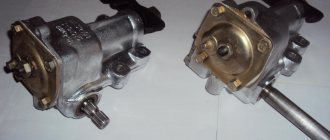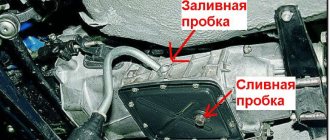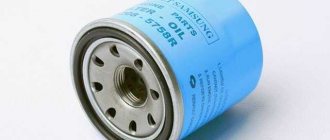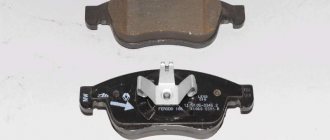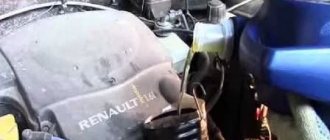Changing the oil in the axle
What and how much oil to fill in the axle and transfer case of Duster 4x4
According to the manufacturer, the oil in the transfer case and axle cannot be replaced and is refilled for the entire service life of the vehicle.
But underfilling the transfer case and axle with oil is a fairly common occurrence on Renault Duster. In this case, it was only 2 cm short of the level, it’s not a big deal, but I had to change it to calm things down.
Since it is not clear what kind of oil was poured in, I had to play it safe and buy a new transmission oil, Total Syn Fe 75W-90, an oil recommended by Renault, which hardens at temperatures below 50 degrees.
To change the oil in the transfer case and axle of a Renault Duster, 1 liter is enough. In this report, it took 1 liter and 50-100 grams, this is when filling to the maximum, to the level of the drain holes and taking into account the complete draining and washing of the rear gearbox and transfer case.
- We start with the rear gearbox
- You don’t have to lift the car; if you lie on the ground, there is enough space.
- Use a hexagon to unscrew the drain plug (bottom)
- Drain the oil, the oil will be quite black, this is normal.
- Screw the plug back in, don’t forget about the gasket
The oil will not all drain out, so you can use a vacuum hose to completely drain the oil.
The hose is a vacuum hose, because the walls do not compress. We insert one end of the hose into the filler hole of the gearbox, resting the hose against the bottom, the other end of the hose to the vacuum pump (or create a vacuum with our lungs), take the hose long so that oil does not get into the pump or be swallowed.
You can also wash the gearbox and drain the flushing fluid completely using this method. The oil drains well from the transfer case; there is no need to rinse it.
It is convenient to pour oil into the rear gearbox using this device
We insert the hose and pour new oil into the filler hole (upper), oil must be filled to the very edge of the hole.
We tighten the top plug on the gearbox and wipe off any traces of oil with a rag after replacement.
Let's move on to the transfer case
We remove the right front wheel (passenger side), you can simply turn it out if it is convenient.
The transfer case is located on the passenger side directly behind the wheel. See photo below.
We find the filler hole, which is also the control hole.
Transfer case oil level was normal.
To access the drain plug, you will have to partially remove the protection by unscrewing the six fastening bolts so that the protection hangs only on the front ones. The transfer case drain plug is indicated by an arrow.
The oil drains well from the transfer case; there is no need to rinse it.
Drain the oil and tighten the drain plug. We assemble the protection in reverse order.
The oil was poured everywhere exactly along the edge of the filler hole (it even spilled out a little).
The control and filler hole of the box is located in the same way as the dispensing hole, but on the left side.
The oil in the box was not changed, only the level was checked - almost level with the edge.
Categories of products that may be of interest to you based on the article “Changing the oil in the gearbox and transfer case of Renault Duster”:
Spare parts, maintenance
Products from the Dustershop77 range that may be of interest to you:
| Name | Manufacturer | Price | Availability | Add to cart |
| DC495 | Discount card (Dusterclubs.ru, Dustershop77.ru) | 700 / 500 rub. Discount: 500 rub. | >10 | |
| DC218 | Air deflector “Warm feet” for Duster, Logan, Sandero, Largus | 900 / 350 rub. Discount: 250 rub. | >10 | |
| DC654 | Frill with fastening without 3M tape (Duster/Terrano) (ArtForm) | ArtForm (Yuago) | 3000 / 2000 rub. Discount: 1600 rub. | >10 |
| PT014-RDU112901 | Trunk sill trim PTGroup | Pt GROUP | 1200 / 1000 rub. Discount: 900 rub. | >10 |
| 005-008502 | Trunk sill protection | Russian Artel | 1400 / 1100 rub. Discount: 1000 rub. | >10 |
| R12711 | Wind deflectors (window deflectors) COBRA/Autoplex | COBRA/Autoplex | 2000 / 1600 rub. Discount: 1500 rub. | >10 |
| DG-006-GARD-RDSHCH | Front diffusers - aerodynamic flaps Renault Duster (set of 2 pieces) | Duster-Guard | 700 / 600 rub. Discount: 500 rub. | >10 |
| NRD-009102 | Frill under the windshield (RA) | Russian Artel | 2500 / 2100 rub. Discount: 1800 rub. | 5 |
| RA0052 | Door sill trims (front+rear) RA | Russian Artel | 2500 / 2000 rub. Discount: 1700 rub. | >10 |
| DC1024-V117 | Windshield and roof edge seal | Duster-Guard | 700 / 500 rub. Discount: 300 rub. | >10 |
Changing the oil in the gearbox
If you have a certain skill, then you can change the transmission fluid yourself, without even lifting the car. For this you will need:
- Ten hexagon for plug.
- Device for filling oil (syringe).
- Containers for waste material.
Sequencing
Drain the oil. Remove the protection from the box, if any. We find holes for drain and fill. Using a hex wrench, unscrew the filler plug and inspect the rubber washer. If damaged, it must be replaced. After this, check the oil level.
For a complete replacement, unscrew the drain plug and empty the gearbox into a container. Use a vacuum to remove any remaining oil from the bottom.
When removing the filler plug, be careful not to damage the delicate rubber gasket.
We wash the part. This procedure is mandatory when switching to another brand of transmission fluid. Flushing can be purchased at a specialty store. The draining procedure is carried out similarly to the previous one.
Add oil. We install the drain plug in place. Through the filler hole, using a syringe with a long tip, fill the transmission to the edge. Screw the plug and remove any leaks that have formed. This completes the process.
Replacement schedule for gearbox and transfer case
Since draining the lubricant requires access to the plugs located on the lower part of the crankcases of the units, the work is performed on a lift or inspection pit. The machine is installed horizontally, which allows you to fully drain the spent liquid from the housings.
To carry out the work, you will need a special 4-sided key measuring 8 mm, a 6-sided key measuring 10 mm, a clean transmission syringe and a container for draining waste with a capacity of 1.5-2.0 liters. To increase the fluidity of the lubricant, it is recommended to warm up the fluid by driving the car for 20-25 km.
Oil drain
To drain spent fluid from the transfer case, you must:
- Wipe the lower part of the crankcase from dirt and grease drips with a clean rag.
- Insert a previously prepared key into the 4-sided hole of the plug and unscrew the element from the unit body.
- Place a container under the hole to collect old grease, which drains for 10-15 minutes.
- Remove any remaining old grease and metal shavings from the plug (the design includes a magnetized element).
To change the oil in the rear gearbox you need:
- Remove dirt from the crankcase using a rag.
- Unscrew the plug located on the rear cover of the unit.
- Drain the liquid into the provided container, wipe the plug to remove oil and adhering wear particles.
Washing elements
The transfer case cavity and the rear wheel drive gear housing are not flushed. The manufacturer provides for the use of API GL5 standard lubricant, which allows mixing liquids with different viscosities. The use of flushing materials is prohibited as they are not compatible with gear oils.
Step-by-step instructions for filling oil
To fill the crankcases of the transfer case and rear axle gearbox with lubricant, use a syringe or a plastic bottle with an extension hose. A section with a neck is cut off from a tank with a capacity of 1-1.5 liters, the tube is secured using electrical insulating tape. It is recommended to use a hose 1.2-1.5 m long, which allows you to refill transmission oil while being next to the machine.
Step-by-step algorithm of actions:
- Screw the drain plugs into the crankcases, and then remove the control plugs that are located on the sides of the unit housings.
- Fill the reservoirs with oil using a syringe or using a bottle with an extension; the liquid is poured until a leak appears from the filler hole. If refilling using a bottle is used, then the help of a second person is required, who visually determines the moment the lubricant begins to leak from the hole. It is recommended to replace it in the summer or in a heated garage.
- Remove the syringe nozzle or hose from the hole, and then install the standard plugs.
Choosing oil
According to the manufacturer's recommendation, the replacement oil must meet the API GL-5 standard . It has the following characteristics:
- Has good anti-scuff properties.
- Provides protection when exposed to high loads.
- They have a complex of anti-corrosion additives.
At production, Renault fills the car with Total 80W90 mineral-based oil (works down to -27°).
This temperature regime is more suitable for European countries or the south of the country. For our climate, it is better to use semi-synthetic liquid Total Syn Fe 75W-90 (pour point -50°). It is also possible to use analogues with similar characteristics, but only when performing a complete oil change.
Car owners prefer to use two types of oil, separate for the gearbox and transfer case. , Elf Tranself Universal FE 80W-90 GL-5 is popular , and for the gearbox - Shell SPIRAX X 75W-90 .
For a complete replacement you need a 1-liter canister . About 750 ml goes into the gearbox, and 250 ml of oil goes into the dispensing mechanism. When carrying out the operation by a beginner, it is better to take 2 liters, as there is a risk of overflow.
For cars of recent years of production, it is better to use synthetic oil, and for older years of production - semi-synthetic or mineral.
Replacement mode
The instructions for the car indicate that an oil change is not required throughout the entire service life. However, the Russian climate and roads are quite harsh, so you should adhere to the following recommendations for changing the oil:
- Carry out a scheduled replacement every 75 thousand kilometers.
- Under difficult driving conditions and aggressive driving conditions, do this every 25,000–30,000 km.
- Top up or change completely if the fluid level drops and there are leaks on the rear axle and transfer case.
- Carry out maintenance regularly and follow the recommendations of professionals.
How to check the oil level in the gearbox?
Important! To speed up the filling process, the oil mixture must first be kept in a warm room. The fluidity of the transmission will increase, the speed of work will increase
Contaminated oil does not remove heat properly and cannot fully lubricate parts. This causes various problems with the manual transmission and the car as a whole. A very dirty lubricant is an abrasive suspension that has a negative effect on all parts and components of systems.
From time to time the driver must check both the quantity and quality of the fluid in the system. It is most convenient to do this with a probe, but other objects will also work, you can use your finger. There are a couple of level marks on the dipstick - minimum and maximum. The test should be carried out in a cold and warm state, so its results will be as accurate as possible.
Oil change intervals
The transfer gearbox is rigidly attached to the gearbox housing; the unit is used on a Duster with a 4x4 drive. The units have separate lubrication systems; torque is transmitted from the differential, which is located in the gearbox housing. The manufacturer provides for checking the transmission oil level in units every 30 thousand kilometers. Lubricant replacement was not initially provided for by the regulations, but since 2016, under severe operating conditions, the plant recommends changing the transmission oil after 2 engine maintenance cycles.
Owners note a reduced fluid level in units when purchasing new cars. In addition, the oil used has a high viscosity, which makes gear shifting difficult at temperatures below -10°C.
During the running-in process, the gears are ground in; metal particles enter the lubricant, which can cause abrasive wear of parts. Primary replacement is carried out at mileages from 20 to 30 thousand km, subsequent maintenance is performed after 30 thousand km (under normal operating conditions).
The transfer case and rear gearbox have ventilation ducts located on the top of the housings. When driving through deep puddles, water may enter the cavities of the units. The car manufacturer requires a lubricant change after the gearboxes are completely immersed in water. If, when repairing a Renault Duster, it is necessary to remove the front right wheel drive, then the oil is drained from the transfer case.
Alternative way
This method may seem more complicated to some, but it allows you to do without a lift and inspection hole. A large syringe is used for this. It is sold in pharmacies and its usual purpose is to rinse the ears.
Work order:
- First you need to remove the front wheel or turn it all the way to the left to gain access to the filler plug.
- After this, you need to unscrew several bolts that hold the gearbox protection.
- After this, the oil is drained through a special hole. This method allows you to completely remove oils, so washing is not required.
- After changing the oil, you need to change the seal on the plug.
How much oil to fill
First generation HSA/HSM, since 2010
The Duster is based on the Nissan VO platform, common with the Nissan Juke and Renault Logan models. The platform has undergone significant changes to adapt to the new axles and Nissan All Mode 4x4 system, which is also used in Renault Koleos, Nissan Qashqai and Nissan Juke. The car is available with front-wheel drive or all-wheel drive, and the luggage compartment volume ranges from 475 to 1636 liters, depending on the position of the rear row seatbacks. Already in the basic configuration, the Duster has steel engine protection, and the ground clearance is 210 mm. In addition, thanks to short overhangs (approach angle - 30 degrees, departure angle - 35 degrees), the crossover performs well off-road among its competitors. In terms of safety, Duster is on the same level as the first generation Renault Logan.
Also read: Oil in gearboxes and axles of Mercedes-Benz Sprinter
Oil in transfer case: volume – 0.9 liters; tolerance and viscosity: API-GL-3.4; SAE 75W-90, 80W-90
Rear axle gearbox oil: volume – 0.9 liters; tolerance and viscosity: API-GL-5; SAE 75W-90, 80W-90, 90W-140
Recommended oil manufacturers
To fill the transfer gear and rear axle crankcases (fluids are changed at the same time), it is recommended to use:
- for cars operated in the middle zone - TransELF Synthese FE 80W90;
- for cars traveling in northern regions - TransELF Synthese FE 75W90.
Information on the types of oil required
For the transfer case, the manufacturer recommends using the following gear oils:
TOTAL TRANSMISSION SYN FE 75W90 GL4/GL5
This is a fully synthetic gear oil developed to comply with the TDL (Total Drive Line) concept. It is used in manual transmissions with and without synchronizers, as well as in axles and transfer cases. Recommended for lubricating systems with filter elements. Among the beneficial qualities of this gear oil, it should be noted:
- Quite a high degree of viscosity.
- Improved resistance to foaming, oxidation and corrosion.
- Increased resistance to harsh temperature conditions.
- Increased resistance to high loads.
- Extended replacement intervals.
ELF TRANSELF TYPE B 80W-90
This high quality transmission fluid contains EP additives. The oil has good anti-wear and extreme pressure properties, due to which it has a positive effect on the service life of mechanisms when operating under high load conditions. The presence of a large number of different useful properties prevents corrosion and oxidation processes on steel and copper elements of units. It has a high viscosity index and low temperature resistance coupled with thermal stability. Does not harm seal materials.


